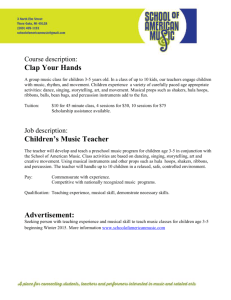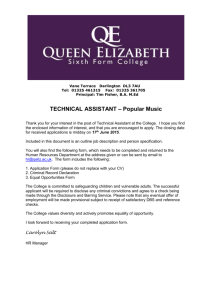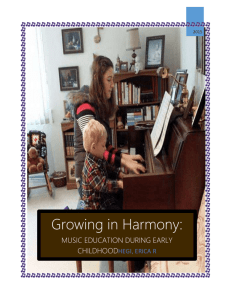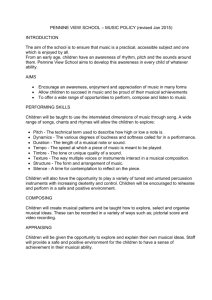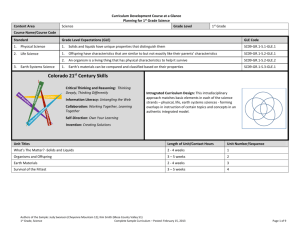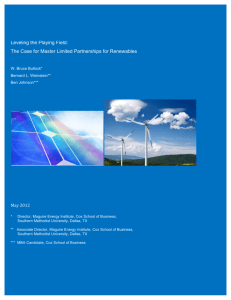Music Tells a Story Instructional Unit
advertisement
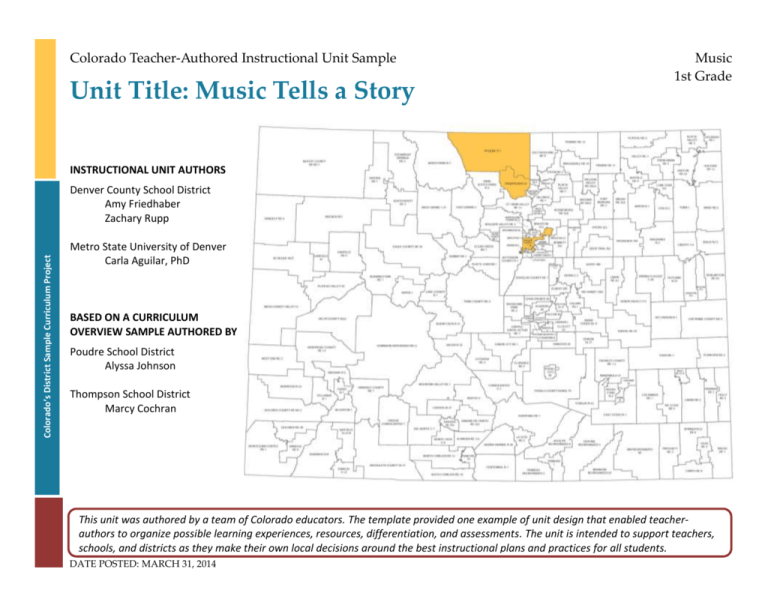
Colorado Teacher-Authored Instructional Unit Sample Unit Title: Music Tells a Story Music 1st Grade INSTRUCTIONAL UNIT AUTHORS Colorado’s District Sample Curriculum Project Denver County School District Amy Friedhaber Zachary Rupp Metro State University of Denver Carla Aguilar, PhD BASED ON A CURRICULUM OVERVIEW SAMPLE AUTHORED BY Poudre School District Alyssa Johnson Thompson School District Marcy Cochran This unit was authored by a team of Colorado educators. The template provided one example of unit design that enabled teacherauthors to organize possible learning experiences, resources, differentiation, and assessments. The unit is intended to support teachers, schools, and districts as they make their own local decisions around the best instructional plans and practices for all students. DATE POSTED: MARCH 31, 2014 Colorado Teacher-Authored Sample Instructional Unit Content Area Music 1st Grade Grade Level Course Name/Course Code Standard Grade Level Expectations (GLE) GLE Code 1. 1. Expressively perform in groups or independently MU09-GR.1-S.1-GLE.1 2. Perform basic rhythmic and melodic patterns MU09-GR.1-S.1-GLE.2 1. Demonstrate creation of short, independent musical phrases and sounds alone and with others MU09-GR.1-S.2-GLE.1 2. Identify musical patterns MU09-GR.1-S.2-GLE.2 1. Comprehension of gradual changes in dynamics and tempo MU09-GR.1-S.3-GLE.1 2. Aurally identify components of musical form MU09-GR.1-S.3-GLE.2 3. Comprehension of basic vocal and instrumental tone colors MU09-GR.1-S.3-GLE.3 4. Comprehension of basic rhythmic and melodic patterns MU09-GR.1-S.3-GLE.4 1. Demonstrate respect for the contributions of self and others in a musical setting MU09-GR.1-S.4-GLE.1 2. Comprehension of basic components of music and musical performance at a beginning level MU09-GR.1-S.4-GLE.2 3. Identify music as an integral part of everyday life MU09-GR.1-S.4-GLE.3 2. 3. 4. Expression of Music Creation of Music Theory of Music Aesthetic Valuation of Music Colorado 21st Century Skills Creation Critical Thinking and Reasoning: Thinking Deeply, Thinking Differently Invention Expression Creative Process Theory Information Literacy: Untangling the Web Aesthetic Valuation Collaboration: Working Together, Learning Together Self-Direction: Own Your Learning Invention: Creating Solutions The Colorado Academic Standards for Music are not intended to be taught in a linear (checklist of coverage) fashion, but rather should be implemented as a cyclical creative process. Each unit within this sample blueprint intentionally includes standards from all four music standards to illustrate this process-based philosophy. Unit Titles Length of Unit/Contact Hours Unit Number/Sequence Music Tells a Story Instructor’s choice Instructor’s choice 1st Grade, Music Unit Title: Music Tells A Story Page 1 of 14 Colorado Teacher-Authored Sample Instructional Unit Unit Title Music Tells a Story Focusing Lens(es) Play/Exploration Length of Unit Standards and Grade Level Expectations Addressed in this Unit Instructor Choice MU09-GR.1-S.1-GLE.1, MU09-GR.1-S.1-GLE.2 MU09-GR.1-S.2-GLE.1 MU09-GR.1-S.3-GLE.1, MU09-GR.1-S.3-GLE.2, MU09-GR.1-S.3-GLE.3 MU09-GR.1-S.4-GLE.1, MU09-GR.1-S.4-GLE.2 Inquiry Questions (EngagingDebatable): Unit Strands Expression, Creation, Theory, Aesthetic Valuation Concepts Tone Color, Phrases, Dynamics, Style, Tempo, Form, Beat, Rhythm, Melody, Improvisation, Movement, Literature How does music tell a story? (MU09-GR.1-S.2-GLE.1) and (MU09-GR.1-S.3-GLE.1,2,3)and(MU09-GR.1-S.4-GLE.2-EO.b) How does music describe a thought or feeling? How does music make you feel different? How does creating something new help you express ideas? What makes music interesting to listen to? What specific music elements can change the feelings described? Generalizations My students will Understand that… Guiding Questions Factual Conceptual Performing music elements enables composition and improvisation of feelings and stories. (MU09-GR.1-S.4GLE.2-EO.b) What movements would show the difference in characteristics and feelings of the characters in (insert story) (i.e. The Bremen Town Musicians)? How do various tone colors imitate different feelings? How can a composition, improvisation, movement, speech, singing, and playing instruments communicate a thought or feeling? How are musical phrases and sentences similar or different? Musical elements translate feelings and stories. (MU09GR.1-S.4-GLE.2-EO.ab) What sounds would show the feelings of the main character in (insert story) (i.e. The Old Lady Who Was Not Afraid of Anything ? How does changing tempo and dynamics change the mood of the music? 1st Grade, Music Unit Title: Music Tells A Story Page 2 of 14 Colorado Teacher-Authored Sample Instructional Unit Critical Content: Key Skills: My students will Know… My students will be able to (Do)… That music tells a story (MU09-GR.1-S.2-GLE.1-EO.a) and (MU09-GR.1S.4-GLE.2-EO.b) Tone colors of voices and instruments are unique (MU09-GR.1-S.3GLE.3-EO.ab) Individuals have the ability to make a variety of vocal sounds (MU09GR.1-S.3-GLE.3-EO.b) How to behave during a musical performance (MU09-GR.1-S.4-GLE.1EO.a,b,c) How an individual contributes to effective music making (MU09-GR.1S.4-GLE.1-EO.a,b,c) How the basic elements of music communicate thoughts or emotions (MU09-GR.1-S.4-GLE.2-EO.b) Identify and demonstrate singing, speaking, whispering, and shouting voices (MU09-GR.1-S.3GLE.3-EO-b) Aurally identify introduction, phrase, AB form, going up/going down, and “s-m-l” or “m-r-d” (MU09-GR.1-S.3-GLE.2,4) Discriminate between same/different rhythmic and melodic patterns (MU09-GR.1-S.3-GLE.4EO.d) Use vocabulary for, and demonstrate with movement, voice, and instruments, getting louder/softer and getting faster/slower (MU09-GR.1-S.3-GLE.1-EO.a,b) Use developmentally appropriate movements in responding to music (MU09-GR.1-S.4-GLE.3EO.c) Display improvisational skills using instruments, voice, and movement. (MU09-GR.1-S.2GLE.1-EO.a,b) and (MU09-GR.1-S.4-GLE.2-EO.a) Improvise, create, and perform short phrases using the” l-s-m” or “m-r-d” tone set and/or rhythms (MU09-GR.1-S.2-GLE.1-EO.a,b) Create instrumental and vocal sounds to accompany poems, rhymes, and stories (MU09-GR.1S.2-GLE.1-EO.a) Create movements to music that reflect focused listening, such as changes in dynamics and AB form (MU09-GR.1-S.3-GLE.1-EO.b) and (MU09-GR.1-S.4-GLE.2-EO.a) Describe how ideas or moods are communicated through music (MU09-GR.1-S.4-GLE.2-EO.b) Participate appropriately in music activities (including sharing, taking turns, and listening respectfully to the ideas of others) (MU09-GR.1-S.4-GLE.1-EO.a) Listen to others perform and reflect on their performance (MU09-GR.1-S4-GLE.1-EO.b) Critical Language: includes the Academic and Technical vocabulary, semantics, and discourse which are particular to and necessary for accessing a given discipline. EXAMPLE: A student in Language Arts can demonstrate the ability to apply and comprehend critical language through the following statement: “Mark Twain exposes the hypocrisy of slavery through the use of satire.” A student in ______________ can demonstrate the ability to apply and comprehend critical language through the following statement(s): Music can tell stories and show feelings of characters. Academic Vocabulary: Beat, opposites, movement, speaking, singing, instruments, same-different, literature, stories, feelings Technical Vocabulary: Quarter Note (ta), Quarter Rest (ta rest), Paired Eighth Notes, (ti-ti) Melody, Sol-Mi-La, Mi-Re-Do, Improvisation, Phrase, Form, Tone Color, fast/slow, loud/soft, 4-beat patterns 1st Grade, Music Unit Title: Music Tells A Story Page 3 of 14 Colorado Teacher-Authored Sample Instructional Unit Unit Description: Considerations: This unit is an exploration of music--singing, playing, and moving--through the storytelling process. Each student will get an opportunity to engage with understanding the mood and emotions related to a story and how musical sounds can be used to demonstrate mood and emotions. Across the unit, students will experiment with and perform musical representations of developmentally appropriate children’s stories. The unit culminates in asking the students to become a musical author and share musical stories in a final performance. This unit focuses on exploration and experimentation with music and how it conveys a story. Students should have a basic understanding of story structure (beginning, middle and end) and the mood and emotions related to a story. Students should also be encouraged to express their thought process for storytelling. Teachers may wish to consider the 1st grade drama unit, which explores the ways in which actors use movement, body language, and verbal communication within unique contexts to convey particular characters’ perspectives and relationships with other characters for integrative possibilities! Unit Generalizations Key Generalization: Performing music elements enables composition and improvisation of feelings and stories Supporting Generalizations: Musical elements translate feelings and stories Performance Assessment: The capstone/summative assessment for this unit. Claims: Performing music elements enables composition and improvisation of feelings and stories. (Key generalization(s) to be mastered and demonstrated through the capstone assessment.) Stimulus Material: (Engaging scenario that includes role, audience, goal/outcome and explicitly connects the key generalization) Product/Evidence: (Expected product from students) 1st Grade, Music You are a group of “musical authors” who have been asked to share a musical story in a performance (informance or recording) with the young students in this school and/or community. To prepare to perform, you will work together to create a story (or retell a story) that will use musical sounds to convey emotions and moods. As experienced musical authors, you know that musical sounds may include vocal production (singing), small percussion, Orff barred instruments, etc., movement or some combination of these musical habits. Students will compose and perform a musical representation of developmentally appropriate children’s stories (story). They will be able to verbally explain story elements through use of musical sounds. Performance options may include: Informance Performance and/or Recording Evaluation criteria will include: Matching instrument choice/singing/movement to emotion Performance of emotion through musical means Verbally describing the instrument choice/singing/movement and chosen emotion. http://tccl.rit.albany.edu/knilt/index.php/Unit_Four:_How_to_incorporate_play_observations_in_the_kindergarten_classroom (Modifiable resource for collecting observational data) Unit Title: Music Tells A Story Page 4 of 14 Colorado Teacher-Authored Sample Instructional Unit Differentiation: (Multiple modes for student expression) Students may demonstrate understanding as a whole group, small group, or individual depending on time and ability in various ways: Singing/using their voice to demonstrate understanding of the use of music to convey feelings and stories. Moving their bodies to demonstrate understanding of the use of music to convey feelings and stories. Playing instruments to demonstrate understanding of the use of music to convey feelings and stories. A combination of singing, moving, and/or playing instruments to demonstrate understanding of the use of music to convey feelings and stories. Texts for independent reading or for class read aloud to support the content Informational/Non-Fiction Fiction The Feelings Book by Todd Parr My Many Colored Days by Dr. Suess (Lexile AD190L) The Snowy Day by Ezra Jack Keats (Lexile AD500L) The Little Old Lady that Wasn’t Afraid of Everything by Linda D. Williams & Megan Lloyd There was an Old Lady who Swallowed a Fly by Lucille Colandro (Lexile AD580L) Ongoing Discipline-Specific Learning Experiences 1. 2. Description: Work/think like a musician- Perform and sing using proper technique for grade level ability Teacher Resources: Visual representation of tempo markings and definitions (standard notation or other teacher created representations) http://nccas.wikispaces.com/Child+Development+Research (College Board Research on developmental stages and arts education) Student Resources: N/A Skills: Demonstrate appropriate instrumental technique, vocal technique, and kinesthetic response for grade level Assessment: Students will accurately demonstrate correct techniques when moving, playing and/or singing https://www.ocps.net/cs/ese/support/curriculum/Documents/A%20Checklis t%20for%20Everything%20Book.pdf (Modifiable collection of checklists to collect observation data) Description: Think like a musician- Listen to others during a sharing and/or performance Teacher Resources: http://msmeganmusic.edublogs.org/2013/09/26/audience-etiquette-andintroduction-to-music/ (Music Teacher’s Blog with ideas for teaching audience etiquette) Student Resources: N/A 1st Grade, Music Unit Title: Music Tells A Story Page 5 of 14 Colorado Teacher-Authored Sample Instructional Unit Skills: Demonstrate expectations for respectful audience etiquette Assessment: Students will demonstrate appropriate audience/performance behavior. https://www.ocps.net/cs/ese/support/curriculum/Documents/A%20Checklis t%20for%20Everything%20Book.pdf (Modifiable collection of checklists to collect observation data) Prior Knowledge and Experiences This unit could take place at any time during the first grade year. It is assumed that the first grade students would have some prior knowledge of developmentally appropriate musical ideas and skills, such as singing, tempos (fast vs. slow), dynamics (loud vs. quiet), and some introduction to various classroom instrument timbres, especially small percussion (drums, triangle, rhythm sticks, etc.). Learning Experiences # 1 – 7 Instructional Timeframe: Teacher Determined Learning Experience # 1 The teacher may use picture books and/or informational texts (in whole or part) focused on the topic of feelings (e.g. The Feelings Book by Todd Parr, My Many Colored Day by Dr. Suess), so that students can begin to build vocabularies related to “feelings” and begin exploring the variety of sounds that can represent feelings. Generalization Connection(s): Musical elements translate feelings and stories Teacher Resources: Recorded musical selections that showcase various moods (e.g., Moonlight Sonata by Beethoven; Stars and Stripes, Forever by Sousa) Pictures of various facial expressions (e.g., happy, melancholy, excited, frustrated) Children’s stories (The Feelings Book by Todd Parr; My Many Colored Days by Dr. Seuss) http://wheatlab.virb.com/dynamics (Emotion in music and movement video and research) Student Resources: N/A Assessment: Students will be able to verbally describe how musical sounds can connect with feelings. Students will begin to create a class word wall of feelings and basic musical elements: http://www.schoolexpress.com/wordwalls/wordwalls.php (Word Wall Templates) Differentiation: (Multiple means for students to access content and multiple modes for student to express understanding.) Access (Resources and/or Process) Expression (Products and/or Performance) Facial expression images http://www.do2learn.com/picturecards/printcards/social_ emotionshealthpeople.htm (Printable cards with various emotion options) http://www.shutterstock.com/cat.mhtml?searchterm=emotio ns&search_group=&lang=en&search_source=search_form (Images of emotions) Students may use a mirror to explore various facial expressions Students may identify emotions by pointing or holding cards depicting facial expression icons 1st Grade, Music Unit Title: Music Tells A Story Page 6 of 14 Colorado Teacher-Authored Sample Instructional Unit Extensions for depth and complexity: Access (Resources and/or Process) Expression (Products and/or Performance) Facial expression images http://www.do2learn.com/picturecards/printcards/social_ emotionshealthpeople.htm (Printable cards with various emotion options) http://www.shutterstock.com/cat.mhtml?searchterm=emotio ns&search_group=&lang=en&search_source=search_form (Images of emotions) Students may demonstrate the opposite expression when a card image is shown Critical Content: How the basic elements of music communicate thoughts or emotions Key Skills: Use developmentally appropriate movements in responding to music Describe how ideas or moods are communicated through music Participate appropriately in music activities (including sharing, taking turns, and listening respectfully to the ideas of others) Critical Language: Opposites, same-different, literature, stories, feelings Learning Experience # 2 The teacher may select key text vocabulary/elements (characters, setting, icons, and text) so that students can connect each vocabulary/elements to a specific instruments and/or movements. Generalization Connection(s): Performing music elements enables composition and improvisation of feelings and stories Musical elements translate feelings and stories Teacher Resources: Pictures/Visuals of key vocab/elements (standard notation or teacher created representations) http://www.do2learn.com/picturecards/printcards/social_emotionshealthpeople.htm (Printable cards with various emotion options) Pitched/non-pitched percussion (e.g., small percussion (triangles, rhythm sticks, finger cymbals), Orff barred instruments, etc.) Non-traditional objects to make sound (bunt pans, rocks, newspaper, etc.) Student Resources: N/A Assessment: Students will make appropriate sound selections to match pictures of emotions or feelings. https://www.ocps.net/cs/ese/support/curriculum/Documents/A%20Checklist%20for%20Everything%20Book.pdf (Modifiable collection of checklists to collect observation data) Differentiation: (Multiple means for students to access content and multiple modes for student to express understanding.) Access (Resources and/or Process) Expression (Products and/or Performance) N/A Students may use movement to match pictures of emotions or feelings to demonstrate understanding Students may verbally describe to match pictures of emotions or feelings to demonstrate understanding 1st Grade, Music Unit Title: Music Tells A Story Page 7 of 14 Colorado Teacher-Authored Sample Instructional Unit Extensions for depth and complexity: Access (Resources and/or Process) Expression (Products and/or Performance) Pitched/non-pitched percussion (e.g., small percussion (triangles, rhythm sticks, finger cymbals), Orff barred instruments, etc.) Non-traditional objects to make sound (bunt pans, rocks, newspaper, etc.) Students may choose emotions that are not in the book and make appropriate musical decisions for those emotions Critical Content: That music tells a story Tone colors of voices and instruments are unique How an individual contributes to effective music making How the basic elements of music communicate thoughts or emotions Key Skills: Use vocabulary for, and demonstrate with movement, voice, and instruments, getting louder/softer and getting faster/slower Use developmentally appropriate movements in responding to music Display improvisational skills using instruments, voice, and movement. Identify and demonstrate singing, speaking, whispering, and shouting voices Individuals have the ability to make a variety of vocal sounds Create instrumental and vocal sounds to accompany poems, rhymes, and stories Create movements to music that reflect focused listening, such as changes in dynamics and AB form Describe how ideas or moods are communicated through music Participate appropriately in music activities (including sharing, taking turns, and listening respectfully to the ideas of others) Listen to others perform and reflect on their performance Critical Language: Movement, speaking, singing, instruments, fast/slow, loud/quiet Learning Experience # 3 The teacher may use key text vocabulary/elements (story and music) so that students can consider some ways that authors and musicians connect stories with music to depict feelings and mood. Generalization Connection(s): Performing music elements enables composition and improvisation of feelings and stories Musical elements translate feelings and stories Teacher Resources: Recorded music selections to reflect contrasting moods (e.g., Moonlight Sonata by Beethoven; Stars and Stripes, Forever by Sousa) Pictures/Visuals from text/story http://www.pinterest.com/debbiescheich/kids-songs/ (videos of different kids songs) http://www.songchest.com/newsdetails.asp?id=4 (example of a graphic musical score) Pitched/non-pitched percussion (e.g., small percussion (triangles, rhythm sticks, finger cymbals), Orff barred instruments, etc.) Written organizer (hard copy) for teacher to capture student sound choices http://www.pinterest.com/nmfoley/retell-sequence-and-map-a-story/ (Story mapping ideas and resources) http://thefirstgradeparade.blogspot.com/2012/03/follow-yellow-brick-road-retelling.html (Story mapping using floor maps) http://www.readingrockets.org/strategies/story_maps (Storymapping resources and instructions) 1st Grade, Music Unit Title: Music Tells A Story Page 8 of 14 Colorado Teacher-Authored Sample Instructional Unit Student Resources: Pictures/Visuals from text/story Pitched/non-pitched percussion (e.g., small percussion (triangles, rhythm sticks, finger cymbals), Orff barred instruments, etc.) Assessment: Students will place story pictures in proper order/sequence to match the story and will connect the visual representation of the story sequence to an instrument (e.g., small percussion (triangles, rhythm sticks, finger cymbals), Orff barred instruments, etc.) http://www.readingrockets.org/oldmedia/storymap.pdf (Beginning/Middle/End Graphic Organizer) http://www.enchantedlearning.com/graphicorganizers/storymap/ (Additional Story Map Graphic Organizers) Differentiation: (Multiple means for students to access content and multiple modes for student to express understanding.) Access (Resources and/or Process) Expression (Products and/or Performance) N/A Students may use movement to match pictures of emotions or feelings to demonstrate understanding Students may verbally describe to match pictures of emotions or feelings to demonstrate understanding Extensions for depth and complexity: Access (Resources and/or Process) Expression (Products and/or Performance) Pitched/non-pitched percussion (e.g., small percussion (triangles, rhythm sticks, finger cymbals), Orff barred instruments, etc.) Non-traditional objects to make sound (bunt pans, rocks, newspaper, etc.) Students may choose emotions that are not in the book and make appropriate musical decisions for those emotions Critical Content: That music tells a story Tone colors of voices and instruments are unique How to behave during a musical performance How an individual contributes to effective music making How the basic elements of music communicate thoughts or emotions Key Skills: Use vocabulary for, and demonstrate with movement, voice, and instruments, getting louder/softer and getting faster/slower Use developmentally appropriate movements in responding to music Display improvisational skills using instruments, voice, and movement. Create instrumental and vocal sounds to accompany poems, rhymes, and stories Create movements to music that reflect focused listening, such as changes in dynamics and AB form Describe how ideas or moods are communicated through music Participate appropriately in music activities (including sharing, taking turns, and listening respectfully to the ideas of others) Listen to others perform and reflect on their performance Critical Language: Movement, speaking, singing, instruments, fast/slow, loud/quiet, improvisation 1st Grade, Music Unit Title: Music Tells A Story Page 9 of 14 Colorado Teacher-Authored Sample Instructional Unit Learning Experience # 4 The teacher may use a picture book and/or informational text (see teacher resources) so that students can begin exploring how to use sounds (body percussion, classroom instruments, vocals, movement, etc.) to explore the power of musical representations of mood, setting, and/or character of the story. Generalization Connection(s): Performing music elements enables composition and improvisation of feelings and stories Musical elements translate feelings and stories Teacher Resources: Recorded music selections to reflect contrasting moods, tempo, dynamics (e.g., Moonlight Sonata by Beethoven; Stars and Stripes, Forever by Sousa) http://www.songchest.com/newsdetails.asp?id=4 (example of a graphic musical score) www.primaryresources.co.uk/music/powerpoint/graphic_scores.ppt (power point with quick explanations of using graphics for musical notation) Pitched/non-pitched percussion (e.g., small percussion (triangles, rhythm sticks, finger cymbals), Orff barred instruments, etc.) Previously completed graphic organizer for story sequence to capture chosen sound selections Student Resources: Pitched/non-pitched percussion (e.g., small percussion (triangles, rhythm sticks, finger cymbals), Orff barred instruments, etc.) Assessment: Students will perform a piece of music that has been organized on a teacher made graphic organizer to retell the story http://www.myfoa.org/docs/mentoring/lessonplans/46GraphicOrganizers.pdf (Resource with various graphic organizer templates/ideas) As new musical pieces are explored, the teacher should record the musical sequences using the same graphic organizer for use in a future lesson. http://cbutler10.blogspot.com/2012/09/listening-journals.html (Journal with prompts around music and emotions) Differentiation: (Multiple means for students to access content and multiple modes for student to express understanding.) Access (Resources and/or Process) Expression (Products and/or Performance) N/A Students may act as a conductor by pointing to the section of music they want students to perform Students may choose to follow music sequence through movement while others perform sounds Student may verbally describe the performance Extensions for depth and complexity: Access (Resources and/or Process) Expression (Products and/or Performance) Additional books with simple stories to perform Students may choose another story to perform and map out using a graphic organizer such as Beginning, middle and end or Chorus in the center and versus surrounding the chorus) Critical Content: 1st Grade, Music That music tells a story Tone colors of voices and instruments are unique How to behave during a musical performance How an individual contributes to effective music making How the basic elements of music communicate thoughts or emotions Unit Title: Music Tells A Story Page 10 of 14 Colorado Teacher-Authored Sample Instructional Unit Key Skills: Critical Language: Form, beat, tone color, phrase, improvisation Use vocabulary for, and demonstrate with movement, voice, and instruments, getting louder/softer and getting faster/slower Use developmentally appropriate movements in responding to music Display improvisational skills using instruments, voice, and movement. Create instrumental and vocal sounds to accompany poems, rhymes, and stories Create movements to music that reflect focused listening, such as changes in dynamics and AB form Describe how ideas or moods are communicated through music Participate appropriately in music activities (including sharing, taking turns, and listening respectfully to the ideas of others) Listen to others perform and reflect on their performance Learning Experience # 5 The teacher may model the rehearsal process so that the students can begin to understand the importance of reflecting on performance. Generalization Connection(s): Performing music elements enables composition and improvisation of feelings and stories Musical elements translate feelings and stories Teacher Resources: Recorded Performance of story #1 Story or Book used in previous activities Pitched/non-pitched percussion (e.g., small percussion (triangles, rhythm sticks, finger cymbals), Orff barred instruments, etc.) http://www.readingrockets.org/oldmedia/storymap.pdf (Beginning/Middle/End Graphic Organizer) http://www.enchantedlearning.com/graphicorganizers/storymap/ (Additional Story Map Graphic Organizers) Student Resources: N/A Assessment: Students will be able to verbally reflect on the performance (e.g., from learning experience #4) Students will be able to perform a sound composition using a new (or unknown) story (teacher should record (written and audio/visual) for use in a future lesson) https://www.ocps.net/cs/ese/support/curriculum/Documents/A%20Checklist%20for%20Everything%20Book.pdf (Modifiable collection of checklists to collect observation data). Differentiation: (Multiple means for students to access content and multiple modes for student to express understanding.) Access (Resources and/or Process) Expression (Products and/or Performance) N/A Students may act as a conductor by pointing to the section of music they want students to perform Students may choose to follow music sequence through movement while others perform sounds Student may draw a picture that depicts the music sequence Extensions for depth and complexity: Access (Resources and/or Process) Expression (Products and/or Performance) N/A N/A Critical Content: 1st Grade, Music That music tells a story Unit Title: Music Tells A Story Page 11 of 14 Colorado Teacher-Authored Sample Instructional Unit How an individual contributes to effective music making How the basic elements of music communicate thoughts or emotions Key Skills: Critical Language: Sol-mi-la, mi-re-do, phrase, form, 4-beat pattern Aurally identify introduction, phrase, AB form, going up/going down, and “s-m-l” or “m-r-d” Improvise, create, and perform short phrases using the “l-s-m” or “m-r-d” tone set and/or rhythms Discriminate between same/different rhythmic and melodic patterns Display improvisational skills using instruments, voice, and movement. Create instrumental and vocal sounds to accompany poems, rhymes, and stories Participate appropriately in music activities (including sharing, taking turns, and listening respectfully to the ideas of others) Listen to others perform and reflect on their performance Learning Experience # 6 The teacher may use a recording of students’ performance(s) so that students can begin exploring the ways in their work effectively connected emotions and musical sounds. Generalization Connection(s): Performing music elements enables composition and improvisation of feelings and stories Teacher Resources: Audio/video recording of performance(s) http://www.teacherspayteachers.com/Product/Listening-Center-Response-Forms-for-Primary-Grades-162398 (Listening Center Response Sheet ideas which can be modified for whole class reflection charts) http://www.lessonplandiva.com/2011/05/freebie-10-page-listening-center.html (printable listening center ideas to modify for whole groups reflection) Student Resources: Audio/video recording of performance(s) Assessment: Students will perform musical story in a “final performance”. Students will verbally describe and verbally reflect on performance experience using appropriate vocabulary around emotions and sounds. https://www.ocps.net/cs/ese/support/curriculum/Documents/A%20Checklist%20for%20Everything%20Book.pdf (Modifiable collection of checklists to collect observation data) http://cbutler10.blogspot.com/2012/09/listening-journals.html (Journal with prompts around music and emotions) Differentiation: (Multiple means for students to access content and multiple modes for student to express understanding.) Access (Resources and/or Process) Expression (Products and/or Performance) http://www.makingmusicfun.net/htm/f_printit_free_printabl e_worksheets/kangaroo-listening-map.htm (Example of a music listening map) http://ofortunaorff.blogspot.com/2012/12/ribbonchoreography-made-easy.html (website with tips on using ribbon choreography) Students may act as a conductor for other students to perform Students may use movement (such as ribbon choreography) instead of instruments or singing Extensions for depth and complexity: Access (Resources and/or Process) Expression (Products and/or Performance) 1st Grade, Music Unit Title: Music Tells A Story Page 12 of 14 Colorado Teacher-Authored Sample Instructional Unit N/A Students may choose their own story (or use a piece provided by the teacher) to create a musical composition to share with others Critical Content: That music tells a story How to behave during a musical performance How an individual contributes to effective music making How the basic elements of music communicate thoughts or emotions Key Skills: Use developmentally appropriate movements in responding to music Create instrumental and vocal sounds to accompany poems, rhymes, and stories Participate appropriately in music activities (including sharing, taking turns, and listening respectfully to the ideas of others) Listen to others perform and reflect on their performance Critical Language: Opposites, movement, speaking, singing, instruments, same-different, stories, feelings, improvisation, form, tone color, loud/quiet, fast/slow Learning Experience # 7 The teacher may use a recording of students’ performance(s) so that students can begin exploring the ways in their work effectively used feelings to tell a story. Generalization Connection(s): Performing music elements enables composition and improvisation of feelings and stories Musical elements translate feelings and stories Teacher Resources: Final recording of story #2 Evaluation rubric for the teacher of the performance and for the process Reflection process outlined by the teacher http://www.teacherspayteachers.com/Product/Listening-Center-Response-Forms-forPrimary-Grades-162398 (Listening Center Response Sheet ideas which can be modified for whole class reflection charts) http://www.lessonplandiva.com/2011/05/freebie-10-page-listening-center.html (Printable listening center ideas to modify for whole groups reflection) Student Resources: Final recording of story #2 Assessment: Students will verbally describe and verbally reflect on performance experience using appropriate vocabulary around music’s ability to tell a story. https://www.ocps.net/cs/ese/support/curriculum/Documents/A%20Checklist%20for%20Everything%20Book.pdf (Modifiable collection of checklists to collect observation data). http://cbutler10.blogspot.com/2012/09/listening-journals.html (Journal with prompts around music and emotions) Differentiation: Access (Resources and/or Process) 1st Grade, Music Unit Title: Music Tells A Story Expression (Products and/or Performance) Page 13 of 14 Colorado Teacher-Authored Sample Instructional Unit (Multiple means for students to access content and multiple modes for student to express understanding.) N/A Students may draw or otherwise use a graphic to describe and reflect on the performance experience Extensions for depth and complexity: Access (Resources and/or Process) Expression (Products and/or Performance) N/A N/A Critical Content: That music tells a story Tone colors of voices and instruments are unique Individuals have the ability to make a variety of vocal sounds How to behave during a musical performance How an individual contributes to effective music making How the basic elements of music communicate thoughts or emotions Key Skills: Aurally identify introduction, phrase, AB form, going up/going down, and “s-m-l” or “m-r-d” Discriminate between same/different rhythmic and melodic patterns Describe how ideas or moods are communicated through music Participate appropriately in music activities (including sharing, taking turns, and listening respectfully to the ideas of others) Listen to others perform and reflect on their performance Critical Language: Opposites, movement, speaking, singing, instruments, same-different, stories, feelings, improvisation, form, tone color, loud/quiet, fast/slow 1st Grade, Music Unit Title: Music Tells A Story Page 14 of 14

